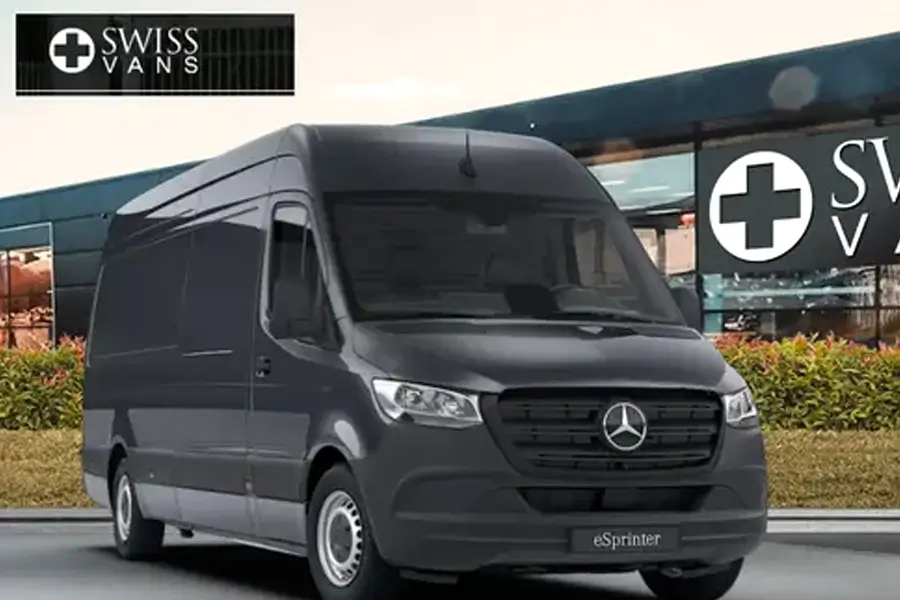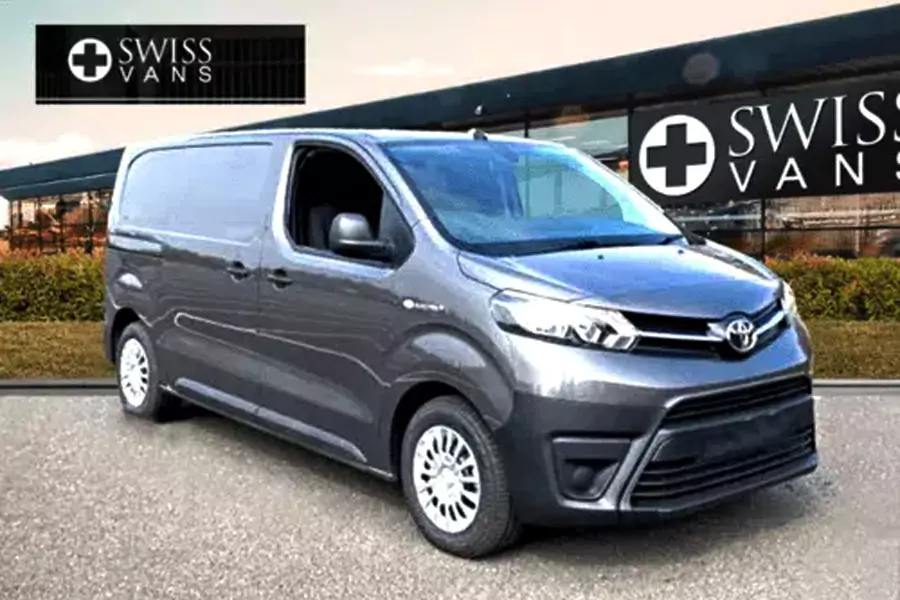Electric Mercedes Sprinter Lease

- Motoring on your terms
Lease type:
£599.00 +VAT per month
Monthly Payment ex VAT
Call Us
ENQUIRE
Get your personalised quote
Call 0118 338 3799
Request a callback
Vehicle Highlights
Discover the Latest Electric Mercedes Sprinter: A Green Revolution in Vans
In the quest for sustainable transportation solutions, the electric Mercedes Sprinter emerges as a game changer, leading a green revolution in the world of electric vans. This innovative model combines the trusted engineering of Mercedes with advanced electric technology, offering a compelling option for businesses looking to reduce their carbon footprint without compromising on performance. With its remarkable driving range, enhanced payload capacity, and state-of-the-art navigation systems, the electric Sprinter sets a new benchmark in the industry, signaling a significant shift towards eco-friendly commercial vehicles.
This article delves into the specifics of the electric Mercedes Sprinter, comparing its features and benefits with those of traditional diesel models to highlight the advancements in electric vehicle technology. Readers will gain insights into the user experience through customer feedback, understand the financial aspects including pricing and leasing options, and explore the technology and safety features that make this electric van a top choice. Additionally, the article will discuss how the electric Sprinter caters to diverse business needs, examine potential challenges and considerations for buyers, and conclude with a summary of its impact on the future of transportation.
Exploring the New Electric Mercedes Sprinter
Design and Features
The 2024 Mercedes-Benz eSprinter has undergone significant upgrades from its predecessors, particularly in terms of interior and exterior design. The cabin has been transformed from a previously utilitarian space into a sophisticated environment, featuring a 10.25-inch touchscreen that dominates the dashboard. This screen houses the latest Mercedes MBUX operating system, providing wireless connectivity for Apple CarPlay and Android Auto, along with over-the-air updates. The design is not only functional but also aesthetically pleasing, making the van’s interior feel less like a traditional commercial vehicle and more like a modern, tech-savvy workspace.
Performance and Range
A standout feature of the new eSprinter is its enhanced battery capacity. The van now boasts a 113kWh battery, propelling it to the forefront of its class with an official maximum range of 271 miles. This substantial range is a significant improvement, positioning the eSprinter as a leader in electric van capabilities. Additionally, the introduction of three driving modes—Comfort, Eco, and Maximum Range—allows drivers to optimize the van’s performance based on their current needs, whether it’s conserving energy or maximizing functionality.
Charging Solutions
Charging the eSprinter is made convenient and efficient through various solutions tailored to different needs. At home, the Mercedes-Benz Wallbox Charger offers up to 11.5 kW charging power, allowing for a faster charge than standard household sockets. For on-the-go charging, the Mercedes me connect App and MBUX multimedia system enable easy location of charging stations, with the ability to filter by speed and availability. The integration of multiple charge point operators into the Mercedes me Charge network provides access to over 80,000 public charging stations across the US, making it one of the largest networks available. Fleet Depot Charging, in partnership with ChargePoint, addresses the needs of larger fleet operators by offering customized charging and telematics solutions to enhance fleet management.
Comparing Electric Sprinter With Traditional Diesel Models
Fuel Efficiency and Operating Costs
The Electric Mercedes Sprinter offers significant savings in terms of fuel efficiency and operating costs compared to traditional diesel models. Traditional diesel Sprinters, while known for their durability and high mileage capabilities, incur higher fuel and maintenance costs. For instance, over a span of 100,000 miles, a diesel Sprinter’s operating expenses can sum up to approximately $21,388. This includes costs for diesel fuel, Diesel Exhaust Fluid (DEF) refills, oil changes, and fuel filter replacements. In contrast, electric vans like the Electric Sprinter benefit from lower energy costs per mile, fewer moving parts requiring maintenance, and exemptions from various taxes and charges such as road tax and congestion charges, which are applicable to diesel vehicles.
Electric vehicles (EVs) generally have a higher initial purchase price but are cheaper to run. The cost of electricity to power an EV is significantly lower than the cost of diesel fuel, and electric vehicles require less routine maintenance than combustion engines, which do not need oil changes or fuel filter replacements. This makes the Electric Sprinter an economical choice for businesses looking to reduce operational costs.
Environmental Impact
The shift from diesel to electric vehicles plays a crucial role in reducing environmental impact. Diesel engines, particularly older models, are significant contributors to air pollution, emitting nitrogen oxides and particulates that can cause respiratory problems and contribute to urban smog. The Electric Sprinter, however, produces zero tailpipe emissions, which means no carbon dioxide or nitrogen oxides are released into the atmosphere during operation. This reduction in greenhouse gases is vital for businesses aiming to improve their environmental footprint and comply with increasingly stringent emissions regulations.
Furthermore, while the production of electricity may still involve the burning of fossil fuels, the overall efficiency and emissions profile of electric vehicles are better than those of diesel engines. The use of renewable energy sources to charge electric vehicles can further decrease the environmental impact, making the Electric Sprinter a more sustainable choice in the long term.
Businesses using the Electric Sprinter can also benefit from various incentives aimed at promoting cleaner technologies, such as exemptions from low-emission zones and congestion charges. These incentives not only reduce operational costs but also support corporate environmental goals.
In summary, the Electric Mercedes Sprinter offers compelling advantages over traditional diesel models in terms of both operating costs and environmental impact, making it an attractive option for businesses looking to invest in sustainable and economically viable transportation solutions.
User Experience: What Customers Are Saying
Comfort and Driveability
Customers frequently highlight the ease of driving the electric Mercedes Sprinter, noting its keyless start system as a particularly convenient feature. One simply enters, presses the start button, and shifts the steering-wheel-mounted shifter to “D” to begin driving. The van offers three driving modes—Comfort, Eco, and Maximum Range—which enhance driving efficiency and adapt to various needs. The Comfort mode, for instance, provides full power and functionality, while the Eco and Maximum Range modes focus on conserving energy, with the latter also reducing certain features like climate control for optimal efficiency.
The electrically-assisted steering, shared with the diesel model, is praised for making the van extremely nimble, especially in urban settings. This steering system, which is lighter than hydraulic options, also supports advanced safety features such as active lane-keeping assist and crosswind assist. The overall handling and ride quality are consistently described as superior, even with the van’s larger size and heavier build compared to many others in its class.
Practicality for Business Use
The practical aspects of the electric Mercedes Sprinter are widely appreciated by business users. The van’s interior is designed for ease of use and functionality, with features like ample storage spaces, including large door bins and under-seat compartments. The dashboard layout allows for additional storage or movement within the cabin, a useful feature for those needing frequent access to the rear of the van.
Visibility and comfort in the cabin are also standout aspects, with adjustable seating and an overall ergonomic design that supports long hours on the road. The MBUX infotainment system, available with 7-inch or 10-inch touchscreens, is a highlight for many, offering intuitive navigation and voice command capabilities that allow for hands-free operation, which is crucial for busy professionals.
For loading and cargo management, the Sprinter is equipped with a flat floor and robust anchoring points, which are essential for securing items during transit. The design of the cargo area is optimized for efficiency, accommodating various business needs with different body lengths, roof heights, and specialized models like crew cabs and chassis cabs. The introduction of front-wheel drive (FWD) models has further enhanced the van’s payload capacity and lowered the loading height, increasing accessibility and versatility for a diverse range of business applications.
Financial Insights: Pricing and Leasing Options
Initial Purchase Price
The Electric Mercedes Sprinter, especially post its 2024 facelift, carries a starting price of more than £73,000. This price point reflects a significant increase, over 50% higher than the original starting price, which can be a critical factor for businesses calculating the return on investment for this electric van. Given the high initial cost, potential buyers should consider the long-term savings in operational and maintenance costs, as well as the environmental benefits of switching to electric vehicles.
Leasing Deals and Offers
Leasing the Electric Mercedes Sprinter can be a more affordable option for businesses not wanting to commit to the high upfront cost of purchasing. Monthly leasing costs vary based on the contract length, with terms available from 24 to 48 months:
- 24 months at £743.20
- 36 months at £674.69
- 48 months at £603.73
These prices exclude VAT and are based on the customer’s postcode, with 72% of customers qualifying for the advertised price. For personal leases, the costs are significantly higher, with monthly payments of £1,186.24 including VAT, and an initial payment of £14,234.88 plus a £270 processing fee. Businesses can benefit from Mercedes-Benz Financial Services for competitive leasing packages, which promise low initial rentals and are backed by a Price Promise to ensure affordability.
Maintenance and Running Costs
The maintenance schedule for the Electric Mercedes Sprinter is set at every 12 months or 40,000 miles, which helps in planning the long-term maintenance budget. While Mercedes-Benz parts and servicing are not the cheapest, the company offers reconditioned parts at lower prices and has made efforts to simplify the replacement of individual components rather than entire assemblies. This approach can reduce the overall cost of maintenance.
Additionally, the Electric Sprinter is included in the MobiloVan plan, which offers up to 30 years of free emergency breakdown assistance, provided the van is serviced at an official Mercedes center. This benefit not only adds value but also saves costs related to additional breakdown coverage.
For businesses considering the Electric Sprinter, it’s essential to weigh these financial aspects carefully against the operational and environmental advantages the vehicle offers.
Technology and Safety Features
Advanced Driver-Assistance Systems
The Electric Mercedes Sprinter is equipped with cutting-edge driver-assistance technologies that enhance both safety and driving experience. Key features include:
- Active Brake Assist with Cross-Traffic Function: This system monitors the distance to the vehicle ahead and provides visual and audible alerts to help prevent collisions. If necessary, it can autonomously bring the van to a full stop.
- Blind Spot Assist and Rear Cross-Traffic Alert: Utilizing radar sensors, these systems detect vehicles in the driver’s blind spot and approaching from the sides while reversing, enhancing safety during lane changes and parking.
- Crosswind Assist: This feature automatically stabilizes the van during strong side winds, ensuring safer handling at higher speeds.
- Digital Rearview Mirror: Replacing the traditional rearview mirror, this digital system uses a rear-mounted camera to provide a clear and wide view of the road behind, unaffected by cargo or cabin obstructions.
These advanced systems not only contribute to safer driving but also ease the typical stresses associated with operating a commercial vehicle, especially in challenging urban environments.
Connectivity and Infotainment
The Electric Mercedes Sprinter sets a high standard for connectivity and infotainment in commercial vehicles with its Mercedes-Benz User Experience (MBUX) system. Highlights of this system include:
- 10.25-inch Touchscreen Display: Dominating the dashboard, this large screen integrates seamlessly with the van’s various functions and provides easy access to navigation and media.
- MBUX Operating System: The latest generation of this system offers enhanced performance, extensive personalization options, and optimized voice control capabilities, making it easier to use while driving.
- Electric Intelligence Navigation: This feature provides real-time updates on range and traffic conditions, calculates the most efficient charging stops, and even plans the best route to ensure the desired state of charge upon arrival.
- Wireless Connectivity: Drivers can connect their smartphones via Apple CarPlay or Android Auto without the need for cables, allowing for safe and convenient use of mobile apps.
The integration of these technological advancements in the Electric Mercedes Sprinter not only improves the driving experience but also supports the driver with tools that make managing an electric vehicle simpler and more intuitive.
Electric Sprinter for Different Business Needs
Cargo Van Configuration
The Electric Mercedes Sprinter is designed to meet various business needs with its versatile cargo van configuration. This electric version of the legendary large panel van is tailored for efficiency and flexibility, making it an ideal choice for businesses aiming for sustainability without sacrificing functionality. The eSprinter offers a multitude of technical innovations, including the largest available battery with a usable capacity of 113 kilowatt hours, ensuring that businesses can cover longer distances with confidence. The load capacity extends up to 14 cubic meters, and the permissible gross vehicle weight reaches up to 4.25 tonnes, accommodating substantial payloads.
Key features enhancing the cargo van utility include:
- 270-degree rear doors with a 90-degree stop: Facilitates easier loading and unloading, even in tight spaces.
- Body builder connector: Allows for various customizations and adaptations, making the eSprinter suitable as a mobile workshop or a spacious delivery van.
- Robust anchoring points: Ensures secure transportation of goods, vital for delivery services and mobile workshops.
Passenger Transportation
Transitioning to passenger transportation, the Electric Mercedes Sprinter excels with configurations that prioritize comfort and accessibility. This model is equipped to serve as a dependable vehicle for passenger transit, offering features that enhance the travel experience for all occupants. The electrically adjustable seats with memory function provide personalized comfort, crucial for long journeys. Additionally, the inclusion of a THERMOTRONIC automatic climate control and a heatable steering wheel ensures that the cabin environment remains pleasant regardless of external weather conditions.
Advanced technology features supporting passenger transportation include:
- MBUX multimedia system with a 10.25-inch screen: Delivers entertainment and real-time navigation updates, improving the overall passenger experience.
- Digital rearview mirror and Blind Spot Assist: Enhance driver visibility and safety, crucial for passenger transportation scenarios.
- Active Brake Assist: Increases safety by helping to prevent potential collisions, providing peace of mind for both drivers and passengers.
Furthermore, the Remote Cabin Convenience and Pre-Conditioning feature, accessible via the Mercedes me connect App, allows for the pre-adjustment of the cabin’s temperature, ensuring maximum comfort upon entry. These thoughtful details underscore the Electric Sprinter’s commitment to providing a superior transportation solution that meets the diverse needs of modern businesses.
Challenges and Considerations
Range Anxiety and Charging Infrastructure
One of the primary concerns for potential adopters of electric vehicles (EVs), including the electric Mercedes Sprinter, is range anxiety. This term refers to the fear that the vehicle will run out of power before reaching a destination or a charging station. The electric Mercedes Sprinter offers different battery options that affect the driving range:
- 56 kWh battery: up to 168 km (104 miles)
- 81 kWh battery: up to 221 km (137 miles)
- 113 kWh battery: up to 300 km (186 miles)
While these ranges are adequate for daily operations, the actual distance can vary based on factors such as driving style, weather conditions, and cargo load. Additionally, the public charging infrastructure, particularly in rural and suburban areas, is not yet sufficiently developed to support the widespread adoption of electric vans. The diversity in charging connectors and the higher power requirements for vans complicate the expansion of a standardized charging network. These challenges necessitate a robust and reliable charging infrastructure to alleviate range anxiety and encourage more businesses to transition to electric vehicles.
Vehicle Size and Capacity Limitations
The electric Mercedes Sprinter, especially the model equipped with a 113 kWh battery, faces challenges related to its size and weight. This larger battery increases the gross vehicle weight to 4.25 tonnes, which may restrict who can legally drive the vehicle based on licensing requirements (drivers who passed their test after January 1, 1997, with a standard license may not qualify). This limitation could affect businesses considering the eSprinter for their fleets, as they might need to ensure drivers have the appropriate licenses or consider models with smaller batteries.
Moreover, the size of the vehicle can make it less maneuverable in urban environments, which is often where electric vans excel due to their zero emissions. The introduction of an 81 kWh battery option later in the year will provide a 3.5-tonne model that may offer a better balance between range and maneuverability, addressing some concerns regarding vehicle size and weight restrictions.
These considerations are crucial for businesses evaluating the electric Mercedes Sprinter against other electric vans and traditional diesel models, as they can significantly impact the practicality and operational feasibility of the vehicle.
Conclusion
As the shift towards sustainable transportation accelerates, the electric Mercedes Sprinter is poised at the forefront, signaling a transformative approach to eco-friendly commercial vehicles. Through a comprehensive examination of its enhanced design, superior battery capacity, innovative charging solutions, and financial insights, it’s clear that this electric van not only addresses but also anticipates the evolving needs of businesses aiming to merge performance with environmental stewardship. The comparison with traditional diesel models further underscores the electric Sprinter’s role in reducing operating costs and environmental impact, making it an attractive proposition for forward-thinking enterprises.
The array of technological advancements and safety features, combined with configurations tailored for diverse business applications, emphasizes the electric Sprinter’s versatility and appeal. Despite the challenges of range anxiety and infrastructure development, the benefits presented by the electric Mercedes Sprinter, from improved operational efficiency to reduced carbon footprint, offer compelling reasons for its adoption. As businesses continue to navigate the transition to more sustainable operations, the electric Sprinter stands as a testament to the tangible benefits of embracing electric mobility solutions.
FAQs
1. What is the Mercedes Sprinter?
The Mercedes-Benz Sprinter is a light commercial vehicle produced by Mercedes-Benz Group AG in Stuttgart, Germany. It is available in various forms including a large van, chassis cab, minibus, and pickup truck.
2. What are the different models available in the Mercedes Sprinter lineup?
The new Sprinter model lineup includes four types of vans:
- Cargo Van: Details available on the Cargo Van build.
- Crew Van: Details available on the Crew Van build.
- Passenger Van: Details available on the Passenger Van build.
- Cab Chassis: Priced starting at $53,000, with more details available on the Cab Chassis build.
3. Is there an electric version of the Mercedes Sprinter?
Yes, Mercedes-Benz has introduced the eSprinter, an all-electric version of the Sprinter van. This marks the first time the eSprinter is available in the U.S., offering a sustainable, emission-free option for fleets.
4. What are common uses for Sprinter vans?
Sprinter vans are versatile and commonly used for various purposes including:
- Delivery services.
- Hauling passengers or cargo.
- Serving as part of a fleet.
I needed a commercial vehicle for private use as I'm not self employed and therefore paying the VAT upfront is quite a chunk of money to loose so needed it to be wrapped up in the monthly repayment. I'd already tried several other companies before Swiss Vans and non of them were interested. I'd pretty much given up and was looking at 2nd Hand vans until I came across Swiss Vans advert on Facebook. I sent a message (with very low expectation) and the next day I was contacted by Tom Jones (yes, a Welshman called Tom Jones who sells vans...!!!). Tom is the first person that actually took the time to listen to what I needed and how I needed it work. He went away and came back a couple of hours later and explained that initially this wasn't going to be easy to achieve but to leave it with him and that he'd call me the next day. To be honest, I didn't think I'd hear from him again but true to his word he called me the next day and said that he had it all worked out, all agreed and all in place ready to go. Tom fired over the paperwork, I paid the small holding deposit and a few weeks later the vans been delivered and completely exceeded my expectations.
I'm a great believer that 'People buy People', yes Swiss Vans are truly excellent and I'd go as far as to say that in my experience, they're better than the rest but like all other companies they're only as good as the people they have working for them. Tom - I can't thank you enough, you're a credit to Swiss Vans, and Swiss Vans - you're outstanding.








